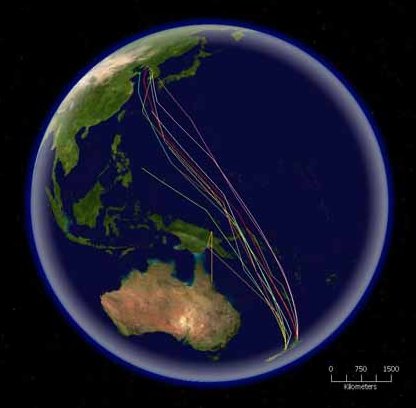Orientation & Navigation

Figure 6.67: An epic journey – the migratory route of the Bar-tailed Godwit entails a 6300 mile non-stop flight from New Zealand to their summer breeding grounds.
Image from URL: http://en.wikipedia.org/wiki/File:Migrationroutes.svg
A number of physical parameters influence bird navigation. Many birds have been shown to use a sun compass. Using the sun for direction involves the need for making compensation based on the time. Navigation has also been shown to be based on a combination of other abilities including the ability to detect magnetic fields, to use visual landmarks, and to use olfactory cues. For more, refer to the article Bird navigation: what type of information does the magnetite-based receptor provide from The Proceedings of the Royal Society.
Long distance migrants are believed to disperse as young birds and form attachments to potential breeding sites and to favorite wintering sites. Once the site attachment is made they show high site-fidelity, visiting the same wintering sites year after year.
These are some great websites with dynamic links to migrating bird activity:
- Bird Migration from birdnature.com.
- Migratory Bird Center from the Smithsonian.
- Numerous Bird Migration pages from CloseToNature.com.
- Educational Resources on Bird Migration from Wild Birds Unlimited.
- Bird Migration from Paul and Bernice Noll’s Window on the World.
- Waterfowl Migration Map from Ducks Unlimited.
- Migration Reports from HawkWatch International.
- HawkWatch International Raptor Migration Sites.